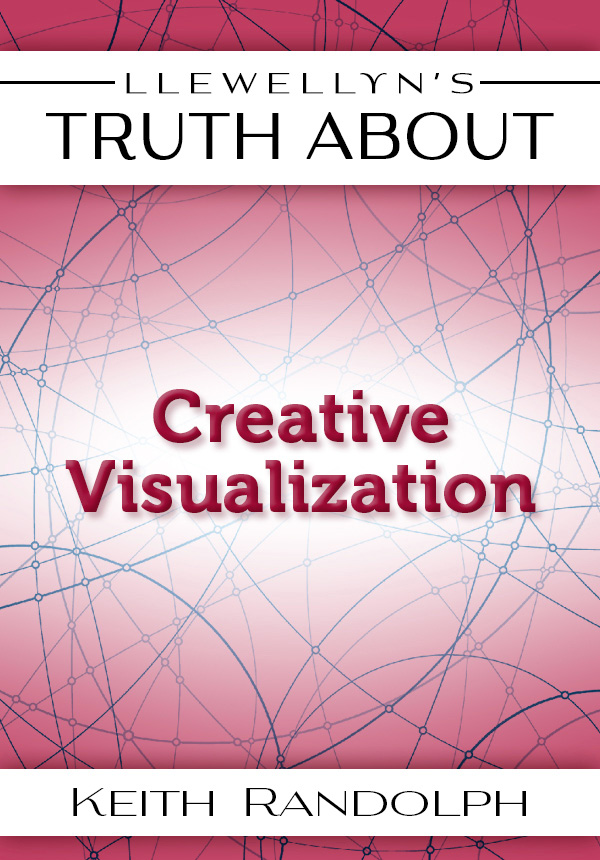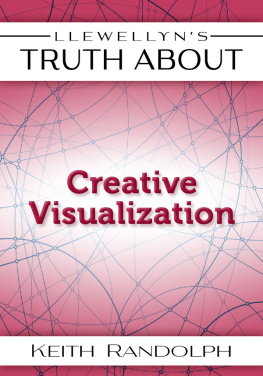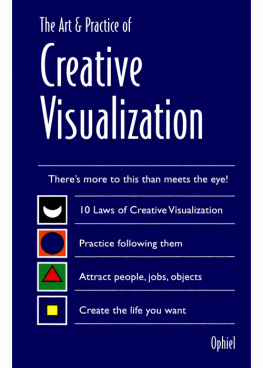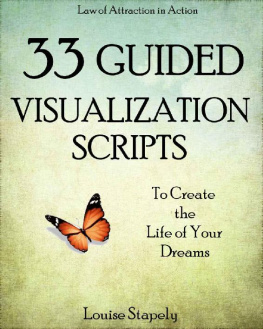Keith Randolph - Llewellyns Truth about Creative Visualization
Here you can read online Keith Randolph - Llewellyns Truth about Creative Visualization full text of the book (entire story) in english for free. Download pdf and epub, get meaning, cover and reviews about this ebook. year: 2013, publisher: Llewellyn Worldwide, LTD., genre: Religion. Description of the work, (preface) as well as reviews are available. Best literature library LitArk.com created for fans of good reading and offers a wide selection of genres:
Romance novel
Science fiction
Adventure
Detective
Science
History
Home and family
Prose
Art
Politics
Computer
Non-fiction
Religion
Business
Children
Humor
Choose a favorite category and find really read worthwhile books. Enjoy immersion in the world of imagination, feel the emotions of the characters or learn something new for yourself, make an fascinating discovery.
- Book:Llewellyns Truth about Creative Visualization
- Author:
- Publisher:Llewellyn Worldwide, LTD.
- Genre:
- Year:2013
- Rating:4 / 5
- Favourites:Add to favourites
- Your mark:
- 80
- 1
- 2
- 3
- 4
- 5
Llewellyns Truth about Creative Visualization: summary, description and annotation
We offer to read an annotation, description, summary or preface (depends on what the author of the book "Llewellyns Truth about Creative Visualization" wrote himself). If you haven't found the necessary information about the book — write in the comments, we will try to find it.
Personal happiness, spiritual development, health, professional success, material wealthcreative visualization can help you succeed at anything. In this book, you will learn:
Basic visualization techniques
How to draw on psychic powers
How to visualize your fear away
How to accomplish specific goals
Llewellyns Truth about Creative Visualization — read online for free the complete book (whole text) full work
Below is the text of the book, divided by pages. System saving the place of the last page read, allows you to conveniently read the book "Llewellyns Truth about Creative Visualization" online for free, without having to search again every time where you left off. Put a bookmark, and you can go to the page where you finished reading at any time.
Font size:
Interval:
Bookmark:

Copyright Information
The Truth About Creative Visualization 1984 and 2013 by Keith Randolph. All rights reserved. Manufactured in the United States of America. No part of this e-book may be used or reproduced in any manner whatsoever including Internet usage, without written permission from Llewellyn Publications, except in the form of brief quotations embodied in critical articles and reviews.
As the purchaser of this e-book, you are granted the non-exclusive, non-transferable right to access and read the text of this e-book on screen. The text may not be otherwise reproduced, transmitted, downloaded, or recorded on any other storage device in any form or by any means.
Any unauthorized usage of the text without express written permission of the publisher is a violation of the authors copyright and is illegal and punishable by law.
First e-book edition 2013
E-book ISBN: 978-0-7387-3860-4
Llewellyn Publications is an imprint of Llewellyn Worldwide Ltd.
Llewellyn Publications does not participate in, endorse, or have any authority or responsibility concerning private business arrangements between our authors and the public.
Any Internet references contained in this work are current at publication time, but the publisher cannot guarantee that a specific reference will continue or be maintained. Please refer to the publishers website for links to current author websites.
Llewellyn Publications
Llewellyn Worldwide Ltd.
2143 Wooddale Drive
Woodbury, MN 55125
www.llewellyn.com
Manufactured in the United States of America
CREATIVE VISUALIZATION: IMAGINING HEALTH
When the patient came to the University of Oregon Medical School, he was barely alive. The 61-year-old man was suffering from a particularly deadly form of throat cancer. His weight had dropped from 130 pounds to 98 pounds. He could barely swallow, and could breathe only with great difficulty. Doctors who examined him gave him less than a five percent chance of living five more years. They even debated among themselves the ethics of giving him cancer treatment, which might only cause him more pain without doing anything to alleviate his illness.
But one of the doctors, Carl Simonton, thought the patient might have a chance. As a cancer specialist, Simonton had begun to wonder if there might not be some connction between mental states and physical health. He had noticed in the course of his practice that some people seemed to exert some level of control of their disease. What made these patients different from other cancer victims was, Simonton said in Getting Well Again (1978), "in their attitude toward their disease and their positive stance toward life."
Simonton had become aware of this curious phenomenon by his wife, Stephanie, a psychologist who had studied individuals who were unusually successful in life. Together the couple had studied various motivational techniques, and they learned that a principal component of them is the practice of visual imagery. In due course they started to wonder if such a practice could regenerate not only the spirit but the body as well.
The visual imagery process involves the individual's setting aside a period for relaxation during which he or she conjures up a mental image depicting a desired result or goal. This exercise is done at least once a day, for anywhere from five minutes to half an hour. Whatever he or she wants to happen is envisioned as a consistent image (either literal or symbolic).
MILLIONS OF ENERGY BULLETS
Dr. Simonton took the patient aside and explained to him what he had in mind. He said he wanted the man to put aside three different periods a day lasting between five and fifteen minutes each. The first period started upon waking, the second at noon, and the third before bedtime. The patient spent each period sitting quietly and thinking of the muscles in his body. He would start at the head and go all the way to the soles of his feet, telling each set of muscles to relax. When this had been accomplished, he would be free of physical and emotional distractions.
Then he was to imagine himself in a pleasant place, perhaps under a tree by a quietly flowing creek. At that point he would think of his cancer, using whatever image he wished to symbolize it. Simonton then directed the man to think of his treatment as a million tiny bullets of energy piercing through every cell that came in their path. While the healthy cells would recover from this attack, the cancer cells would be too weak to repair themselves and would die. The last image was to be of the patient's white blood cells swarming over the dead and dying cancer cells, carrying them off and flushing them out of his body through the liver and kidneys. At the conclusion of the vision, he would visualize his cancer as it continually decreased in size.
Simonton was astonished to witness what happened next.
The patient went through radiation therapy with practically no negative side effects. Soon he was eating again. His strength and weight returned. And the cancer disappeared. He told Simonton that he had missed only one imagery session, and that had happened because a friend with whom he'd gone for a drive had gotten stuck in a traffic jam. This experience upset the patient because he feared losing control over his situation.
After two months of Simonton's mental-imagery program, in addition to conventional therapy, all signs of cancer were gone. Toward the end of the treatment, the patient told Simonton, "Doctor, in the beginning I needed you in order to get well. Now I think you could disappear and I would still make it on my own."
As if to prove it, he went on to treat other ailments from which he suffered. The first of these was arthritis, with which he had been afflicted for many years. In his mind he pictured his white blood cells smoothing over the joint surfaces of his arms and legs; as the cells passed over, they carried away debris, leaving the surfaces smooth and glistening. His arthritic symptoms declined. Although they still flared up from time to time, he was always able to diminish them so that they did not get in the way of anything he wanted to do, especially stream fishinga rigorous sport even for those without arthritis. Another problem he was able to overcome was impotence, which had effectively ended his sex life 20 years earlier. Using visualization exercises, he was able to resume full sexual activity within a few weeks.
Six years later, when Simonton described his patient's experiences in his book, he reported that the man's "condition in all of these areas has remained healthy for over six years."
VISUALIZATION WORKS!
Simonton emphasized that this story, while certainly dramatic, was hardly unique in his experience as a physician dealing with cancer patients. "Although it sometimes made no difference in the illness," he wrote, "in most cases it made significant changes in patients' responses to treatment."
Wanting to precisely and scientifically measure the effectiveness of visualization in cancer treatment, Simonton and his wife worked with a group of 159 patients, all diagnosed as suffering from medically incurable malignant cancer. All were expected to die within 12 months. Four years later, 63 patients were still alive; 14 of them exhibited no evidence of cancer; and 12 others were seeing their tumors shrinking. Even the patients who had died, however, had lived 112 times longer than patients in a control group not using visualization alongside medical treatment.
It should be emphasized here that the Simontons and their patients were not using visualization alone. It was being used in association with conventional medical treatment, whose effectiveness the Simontons believed could be enhanced if combined with the kind of positive mental attitude visualization is intended to inspire.In addition to relieving some of the physical distress of the cancer, Dr. Simonton found that visualization improved the general quality of the patients' lives. Many of the patients regained their energies so sufficiently that they resumed a level of personal activity comparable to what they had experienced before they got sick. As Simonton concluded his findings:
Font size:
Interval:
Bookmark:
Similar books «Llewellyns Truth about Creative Visualization»
Look at similar books to Llewellyns Truth about Creative Visualization. We have selected literature similar in name and meaning in the hope of providing readers with more options to find new, interesting, not yet read works.
Discussion, reviews of the book Llewellyns Truth about Creative Visualization and just readers' own opinions. Leave your comments, write what you think about the work, its meaning or the main characters. Specify what exactly you liked and what you didn't like, and why you think so.









